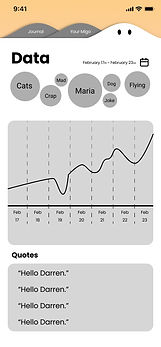




Background
Duration:
~2 Months
Software:
Figma, Miro, Photoshop
Elements Designed:
App, Physical
Team Members:
Lydia Goshen
Gaige Dickerson
Daniel Moo Young Kim
My Role:
System Architect
What I Learned
Designing the physical aspect of Migo, and figuring out how all the parts interact between the app and physical was my primary responsibility. This is the first time I got to do a sensory cue kit to guide my design, which I found to be surprisingly insightful.
This project also taught me about the pain of a late design pivot, and the necessity of important user feedback early on in the design. We felt confident in our third iteration design until our user testing. There was a disconnect between the goal of the product, and the tone of the interface. That was a valuable point to learn.
Problem/Solution
From young adults to senior citizens, loneliness effects various aspects of a persons mental and physical health and is, according to a Cigna study, on the rise.
To create a system that facilitates emotional independence and stability, while reminding users of their existing support networks to aid with feelings of loneliness.
Project Overview
Migo is a plant terrarium that the user cares for through the act of talking. Migo takes care of the rest.
The user discusses their day, their feelings, the positives or negatives, and the plant will be watered and get the nutrients it needs in order to prosper.
The plant reflects the users level of communication, so the healthier the plant is the healthier the users communication level, which aids in feeling less lonely.
View the entire process book with the button below.
Value Proposition
Stability
Guidance
Companionship
To keep the plant in Migo alive, all the user needs to do is talk to Migo about their day, providing a routine that helps the user reflect.
Migo uses word recognition to detect how the user feels, and generates prompts based on that to help guide and strengthen a healthy mindset.
The audio/visual reactions that Migo has, along with contact outreach provides companionship both with Migo, and with users friends and family.
Research
My team and I went though several rounds of research, starting with our secondary research, which looked into the causes of loneliness and possible aids to it.
Our primary research consisted of:
-
A Survey with 140 responses
-
20 Interviews
-
Competitive Analysis of 12 competitors
-
A Sensory Cue Kit
From here we gathered all of our data to begin the affinity mapping process.

Persona



Affinitization
From 230+ data points, down to 5 key insights.


1.
Talking to others about their emotions and the way they feel makes users feel less alone.
2.
Talking to our plants, and in turn themselves, makes users feel better because it feels like someone is listening to them.
3.
Users enjoy the responsibility that is required in taking care of a plant, which is even easier in a terrarium. Visual cues of a plants health helps make that easier.
4.
Labeling users emotions over time allows them to see positive trends, making them feel better about the progress they made.
5.
Being around plants of any kind makes users more concentrated, less anxious, and improves users overall mood and well-being.
First Design Iteration





Second Design Iteration




User Testing Findings:
Migo was last watered when the user talked, so water gauge is pointless.
Journal page layout is too blocky and hard to read.
"Data" sounds too robotic, rename it to something more meaningful.
Quotes is a good idea so the user can look back on how they used to feel.
Physical is a step in the right direction. Eyes need more emotion.
Third Design Iteration



User Testing Findings:
The app attempts to solve a serious problem, but feels childish.
Double down on labeling topics that people talk about, so they can look back on things they enjoy.
Line graph doesn't give enough data on user mood or Migo health.
Design of physical looks great, lighten color and add texture.

Final Design Iteration


List of features:
Talking about your day/feelings, automatically waters Migo.
Migo determines what the user enjoys doing by tracking what the user says and their inflection/tone when they say it.
Migo can respond through the app, promoting a healthy mindset and encouraging activities the user may enjoy.
The Migo plant reflects the users mental health, making it easier to see when the user hasn't talked about how they're doing.


Final Renders





Gaige Dickerson
Project Manager


Daniel M.Y. Kim
Content Strategist
Lydia Goshen
Lead Researcher

Darren Wells